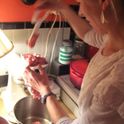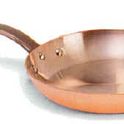Bread bakers! What are your methods and your secrets?
I think I finally [finally!] got some sourdough starter .... well, started! My 'batards' are in the oven now. The directions had me fire up the oven ONE HOUR before baking and with a cast iron skillet in it to boot. In the next paragraph of the recipe, I found out I was supposed to put ice cubes in those skillets after I slid the loaves off the peel. Now I was vaguely aware that some breads (baguettes?) get misted during bake-time but the ice-cubes-in-hot-skillet seemed ingenious to me. So, what are your bread baking methods or secrets? Thanks! And, what else do you make with your sourdough or levain? Crackers?
17 Comments
I made a tutorial recently to make homemade bread (you can eat it with sweet food as well as any kind of meal):
https://www.youtube.com...
I hope it can help you! :)
http://thesolitarycook.wordpress.com/2012/02/01/lets-bake-bagels-part-1/
Enjoy your travels!
Things I've learned: Use an instant read thermometer to check the loaves -- my favorite whole grain bread is done at 195F; I believe Julia Child recommended 203F for Euro-type breads. Buy the best bread flour you can. Use the autolyse technique for leaner loaves. Bagels and pretzel-like breads are soooo much better after a night in the fridge before boiling/baking. Well, most breads are. Using a scale for rolls or bagels makes the finished product look more professional, and they all bake at the same time.
The Friend has perfected sour dough for pizzas -- he does the whole pineapple juice starter thing, and the crust comes out as thin and crackly as one could hope. Just wish I liked sour dough better than I do.
Question for Boulangere: I'm headed back overseas, where HG flour is scarce, and shipping costs are high. Does adding vital wheat gluten to regular flour really approximate a good HG flour?
http://www.food52.com/recipes...
A few keys:
- the longer the resting time, the better (to a point), between mixing the dough & first proofing. Time = flavour as the yeast slowly feeds. Retard it in the fridge overnight or even 2 nights before bringing to room temp and starting the proofing process.
- learning how to shape is critical - particularly the concept of stretching the dough to form a taut surface. My chef instructor used to say "you want the yeast to fill a shape, not create a shape" and with a tight structure it will be a nice, neat loaf. Start this process from the first shaping into a ball to do the first proof.
- Old doughs can be good flavour in a new bread (e.g. leftover uncooked pizza dough). It acts as a biga - just break it up and toss it into the dough as it's mixing.
- If you really want to geek out, check out the book "Bread Science"
Something about professionals with time tested recipes and ovens that cannot be duplicated at home.
As "foodies" we don't have to do everything from scratch at home.
You shouldn't put water in it tho. http://www.amazon.com/dp...
I heat it up with the lid and put in the bread. Then put the lid on...The moisture from the bread is trapped in the high dome lid, which steams it for the first bits of cooking.
After a few mins, take off the lid and let the loaf finish baking to brown.
It's almost like a mini-oven inside your oven.
It's perfect for no-kneed breads. It's made of clay and the clay process they use makes it safe to use on stove top for tagines, roasts, stews etc.
The only draw back is that is kinda large with lid and storage is a problem.







